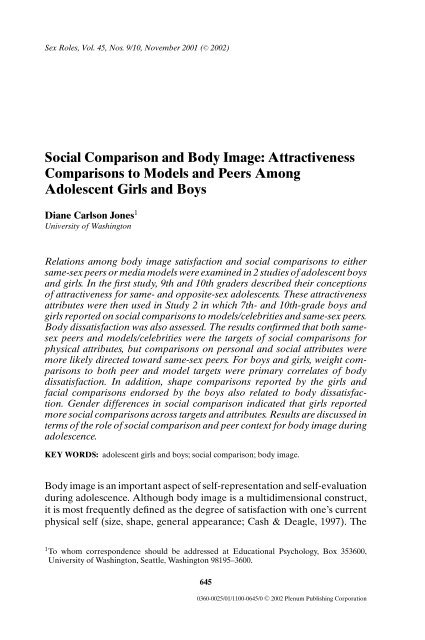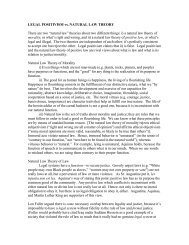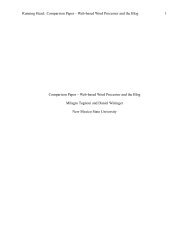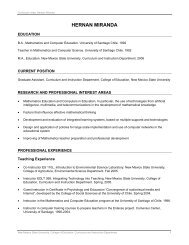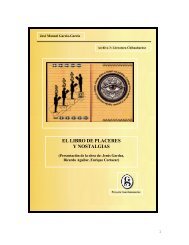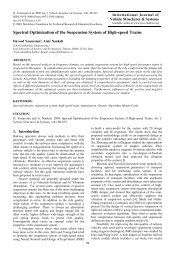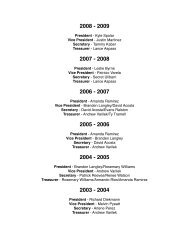Social Comparison and Body Image: Attractiveness Comparisons to ...
Social Comparison and Body Image: Attractiveness Comparisons to ...
Social Comparison and Body Image: Attractiveness Comparisons to ...
Create successful ePaper yourself
Turn your PDF publications into a flip-book with our unique Google optimized e-Paper software.
Sex Roles, Vol. 45, Nos. 9/10, November 2001 ( C○ 2002)<br />
<strong>Social</strong> <strong>Comparison</strong> <strong>and</strong> <strong>Body</strong> <strong>Image</strong>: <strong>Attractiveness</strong><br />
<strong>Comparison</strong>s <strong>to</strong> Models <strong>and</strong> Peers Among<br />
Adolescent Girls <strong>and</strong> Boys<br />
Diane Carlson Jones 1<br />
University of Washing<strong>to</strong>n<br />
Relations among body image satisfaction <strong>and</strong> social comparisons <strong>to</strong> either<br />
same-sex peers or media models were examined in 2 studies of adolescent boys<br />
<strong>and</strong> girls. In the first study, 9th <strong>and</strong> 10th graders described their conceptions<br />
of attractiveness for same- <strong>and</strong> opposite-sex adolescents. These attractiveness<br />
attributes were then used in Study 2 in which 7th- <strong>and</strong> 10th-grade boys <strong>and</strong><br />
girls reported on social comparisons <strong>to</strong> models/celebrities <strong>and</strong> same-sex peers.<br />
<strong>Body</strong> dissatisfaction was also assessed. The results confirmed that both samesex<br />
peers <strong>and</strong> models/celebrities were the targets of social comparisons for<br />
physical attributes, but comparisons on personal <strong>and</strong> social attributes were<br />
more likely directed <strong>to</strong>ward same-sex peers. For boys <strong>and</strong> girls, weight comparisons<br />
<strong>to</strong> both peer <strong>and</strong> model targets were primary correlates of body<br />
dissatisfaction. In addition, shape comparisons reported by the girls <strong>and</strong><br />
facial comparisons endorsed by the boys also related <strong>to</strong> body dissatisfaction.<br />
Gender differences in social comparison indicated that girls reported<br />
more social comparisons across targets <strong>and</strong> attributes. Results are discussed in<br />
terms of the role of social comparison <strong>and</strong> peer context for body image during<br />
adolescence.<br />
KEY WORDS: adolescent girls <strong>and</strong> boys; social comparison; body image.<br />
<strong>Body</strong> image is an important aspect of self-representation <strong>and</strong> self-evaluation<br />
during adolescence. Although body image is a multidimensional construct,<br />
it is most frequently defined as the degree of satisfaction with one’s current<br />
physical self (size, shape, general appearance; Cash & Deagle, 1997). The<br />
1 To whom correspondence should be addressed at Educational Psychology, Box 353600,<br />
University of Washing<strong>to</strong>n, Seattle, Washing<strong>to</strong>n 98195–3600.<br />
645<br />
0360-0025/01/1100-0645/0 C○ 2002 Plenum Publishing Corporation
646 Jones<br />
importance of body image is evident in its relationship <strong>to</strong> risk status for<br />
eating disorders, depression, <strong>and</strong> low self esteem (Attie & Brooks-Gunn,<br />
1989; Harter, 1998; Leon, Fulkerson, Perry, & Cudeck, 1993; Ricciardelli &<br />
McCabe, 2001; Richards, Casper, & Larson, 1990).<br />
One fac<strong>to</strong>r that has been considered a central contribu<strong>to</strong>r <strong>to</strong> body image<br />
is social comparison. <strong>Social</strong> comparison refers <strong>to</strong> the cognitive judgments<br />
that people make about their own attributes compared <strong>to</strong> others. The<br />
comparisons are pivotal <strong>to</strong> self-evaluations <strong>and</strong> depend less on objective<br />
circumstances than on how one judges the self in relation <strong>to</strong> others on a<br />
particular attribute (Wood, 1989). In theory, individuals prefer <strong>to</strong> compare<br />
themselves <strong>to</strong> others who are similar for the attribute of concern (Miller,<br />
Turnbull, & McFarl<strong>and</strong>, 1988). <strong>Social</strong> comparison can also be employed <strong>to</strong><br />
gather information about highly valued attributes, social expectations, <strong>and</strong><br />
norms (Ruble, 1983; Wood, 1989) so that comparisons may be made <strong>to</strong> a<br />
variety of targets.<br />
The empirical relationship between social comparison <strong>and</strong> body image<br />
has been evaluated among college students, primarily for women. The<br />
general finding has been that females who have reported more appearancerelated<br />
social comparisons have been more likely <strong>to</strong> be dissatisfied with their<br />
body images (Faith, Leone, & Allison, 1997; S<strong>to</strong>rmer & Thompson, 1996;<br />
Thompson, Coovert, & S<strong>to</strong>rmer, 1999). The linkage between social comparison<br />
<strong>and</strong> negative body image may be enhanced in the research because the<br />
targets of the appearance comparisons have frequently been models <strong>and</strong><br />
celebrities presented in the media (Botta, 1999; Taylor et al., 1998). Media<br />
images of thin females <strong>and</strong> muscular males represent idealized versions of<br />
physical attractiveness. Analyses of appearance magazines have revealed a<br />
steady bombardment of images that have underscored the importance of<br />
idealized appearance (Cusumano & Thompson, 1997; Spitzer, Henderson,<br />
& Zivian, 1999). The repeated media images of thin females <strong>and</strong> muscular<br />
males make these forms seemingly the st<strong>and</strong>ard of attractiveness. <strong>Social</strong><br />
comparison <strong>to</strong> these idealized images then appears <strong>to</strong> promote a discrepancy<br />
between the attractiveness of self <strong>and</strong> other, leading <strong>to</strong> a more negative<br />
evaluation of self.<br />
The existing research provides evidence supporting the relevance of<br />
social comparison for body image evaluation. There are, however, several<br />
limitations <strong>to</strong> note. First, there is little information on appearance-related<br />
social comparisons during adolescence even though there are clear indications<br />
that social comparison is employed by early adolescents <strong>to</strong> evaluate<br />
their academic competence among peers (Ruble, 1983). Given the physical<br />
changes associated with puberty <strong>and</strong> the importance of appearance for selfesteem,<br />
knowledge about the development of appearance social comparison<br />
for both boys <strong>and</strong> girls may be particularly helpful in underst<strong>and</strong>ing the
<strong>Social</strong> <strong>Comparison</strong> <strong>and</strong> <strong>Body</strong> <strong>Image</strong> 647<br />
dynamics associated with the changes <strong>and</strong> expectations surrounding body<br />
image.<br />
Second, previous research has not considered the role of social comparison<br />
in the body image satisfaction of males so that gender differences <strong>and</strong><br />
similarities in social comparison have not been explored. Although the body<br />
satisfaction has typically been higher among males than among females, the<br />
body image concerns of males have reportedly increased in recent years <strong>and</strong><br />
have been linked <strong>to</strong> adjustment issues (Abell & Richards, 1996; Cohane &<br />
Pope, 2001; Lerner et al., 1991). Given the significant relationship between<br />
social comparison <strong>and</strong> negative body image in college women, it is important<br />
<strong>to</strong> evaluate the role of social comparison in the self-evaluation of body<br />
image for adolescent males as well.<br />
Third, existing research has focused primarily on models/celebrities as<br />
targets for appearance comparisons during adolescence. However, comparison<br />
targets can be selected not only from the distal world of the media,<br />
but also from everyday life. Peers are a vital part of the lives of adolescents<br />
<strong>and</strong> play an increasingly prominent role in defining social expectations,<br />
establishing identity, <strong>and</strong> evaluating self (Brown, Mory, & Kinney, 1994).<br />
Feeling accepted <strong>and</strong> supported by friends <strong>and</strong> classmates is indeed one<br />
of the central concerns of adolescents (Bukowski, Hoza, & Boivin, 1993).<br />
Furthermore, studies have indicated that students at a young age are cognizant<br />
of the linkage between conforming <strong>to</strong> appearance expectations <strong>and</strong><br />
acceptance among peers (Oliver & Thelen, 1996). During adolescence, girls<br />
have reported that they feel like they are being judged on appearance <strong>and</strong><br />
are pressured by peers <strong>to</strong> conform <strong>to</strong> appearance expectations (Merten,<br />
1996; Milkie, 1999; Pax<strong>to</strong>n, Schutz, Wertheim, & Muir, 1999; Taylor et al.,<br />
1998).<br />
Given that appearance is one of the potential routes <strong>to</strong> acceptance <strong>and</strong><br />
popularity, social comparison becomes a relevant mechanism for learning<br />
about the appearance-related social expectations among peers <strong>and</strong> for evaluating<br />
the self in terms of those st<strong>and</strong>ards. Yet peers as targets of social<br />
comparison have not figured prominently in the literature. When classmates<br />
have been distinguished as targets of appearance comparisons among college<br />
women, these comparisons have resulted in heightened body dissatisfaction<br />
(Heinberg & Thompson, 1992a, 1992b). Unfortunately, research<br />
has not focused on the frequency with which adolescent girls <strong>and</strong> boys<br />
select peers as targets of social comparison compared with models <strong>and</strong><br />
celebrities.<br />
Fourth, previous research has not specified the particular attractiveness<br />
attributes that are involved in appearance social comparisons, but have assessed<br />
attractiveness as a global phenomenon. However, reliance upon such<br />
a global approach does not permit an analysis of the relevance of various
648 Jones<br />
attributes for social comparison processes. Attention <strong>to</strong> specific attributes<br />
is important because gender differences in the attributes contributing <strong>to</strong><br />
attractiveness <strong>and</strong> body satisfaction have been noted. For example, personality<br />
characteristics have been confirmed as determinants of physical<br />
attractiveness ratings, especially those made by college females (Jensen-<br />
Campbell, Graziano, & West, 1995). Furthermore, previous research has<br />
identified gender differences in the attributes associated with body image.<br />
Weight has been a primary feature predicting body dissatisfaction among<br />
females whereas the attractiveness concerns of males have been associated<br />
with height <strong>and</strong> shoulders/muscular shape (Abell & Richards, 1996; Franzoi<br />
& Herzog, 1987; Graziano, Brothen, & Berscheid, 1978). It is through examining<br />
specific attractiveness attributes that a better underst<strong>and</strong>ing of<br />
social comparison <strong>and</strong> body image for adolescent boys <strong>and</strong> girls will be<br />
possible.<br />
The purpose of the current research was <strong>to</strong> overcome limitations in<br />
previous studies by examining attractiveness social comparison during adolescence<br />
through the self-reports of boys <strong>and</strong> girls from 7th <strong>and</strong> 10th grades.<br />
The research was guided by four questions. What are the attributes of attractiveness<br />
as defined by adolescents? Are there gender differences in these<br />
attractiveness attributes? Are there differences in the frequency with which<br />
adolescent boys <strong>and</strong> girls report same-sex peers or models as targets of social<br />
comparisons? Are there differential relationships in targets/attributes<br />
of social comparison <strong>and</strong> body image satisfaction?<br />
The answers <strong>to</strong> these questions were obtained in two separate studies.<br />
In the first study, participants described their conceptions of attractiveness<br />
for same- <strong>and</strong> opposite-sex adolescents. These attractiveness attributes were<br />
then used in Study 2 <strong>to</strong> assess the self-reported frequency with which adolescents<br />
compared themselves <strong>to</strong> model/celebrities or peers <strong>and</strong> <strong>to</strong> determine<br />
the relationship between social comparison <strong>and</strong> body image satisfaction for<br />
boys <strong>and</strong> girls.<br />
STUDY 1<br />
The first goal of this initial study was <strong>to</strong> identify the features that define<br />
ideal attractiveness for adolescents. Previous studies that have assessed<br />
cultural st<strong>and</strong>ards or ideals have either been limited <strong>to</strong> college students who<br />
were provided a specific set of attributes such as weight or shape (Fallon &<br />
Rozin, 1985) or a st<strong>and</strong>ardized list of body parts for participants <strong>to</strong> evaluate<br />
(Franzoi & Herzog, 1987). These constrained approaches have not necessarily<br />
captured the range of attractiveness features that may be salient <strong>to</strong> adolescents.<br />
Therefore, an open-ended format was used <strong>to</strong> elicit the attractiveness
<strong>Social</strong> <strong>Comparison</strong> <strong>and</strong> <strong>Body</strong> <strong>Image</strong> 649<br />
attributes so that the elements most central <strong>to</strong> adolescents’ ideal attractiveness<br />
conceptions could be identified.<br />
An additional purpose of this study was <strong>to</strong> examine the gender differences<br />
<strong>and</strong> similarities in the conceptions of attractiveness among teenage<br />
boys <strong>and</strong> girls. As noted earlier, there are gender differences in the attributes<br />
that contribute <strong>to</strong> attractiveness judgments. It is unclear from existing research<br />
if both female <strong>and</strong> male adolescents endorse these attractiveness<br />
attributes for same- <strong>and</strong> opposite-sex peers. Even though there is some evidence<br />
of congruence in the physical features defining attractiveness (Franzoi<br />
& Herzog, 1987) for college males <strong>and</strong> females, other research reveals that<br />
adolescents (Cohn et al., 1987) <strong>and</strong> college students (Fallon & Rozin, 1985)<br />
hold dis<strong>to</strong>rted perceptions of opposite-sex preferences. In addition, nonphysical<br />
characteristics have been identified as important determinants of<br />
physical attractiveness judgments, especially those made by females (Jensen-<br />
Campbell et al., 1995).<br />
Method<br />
Participants<br />
The sample included 42 girls <strong>and</strong> 38 boys in 9th <strong>and</strong> 10th grades of a<br />
public high school. The participants were 98% White <strong>and</strong> middle- <strong>to</strong> uppermiddle<br />
class. Passive parental consent <strong>and</strong> student assent were provided.<br />
Measures<br />
<strong>Attractiveness</strong> Attributes. In classroom settings, the students responded<br />
<strong>to</strong> a survey in which they were asked <strong>to</strong> write a description of their ideal image<br />
of attractiveness for both a teenage girl <strong>and</strong> for a teenage boy. In this way, the<br />
same-sex <strong>and</strong> opposite-sex attractiveness conceptions were obtained from<br />
both boys <strong>and</strong> girls.<br />
The open-ended, written responses were reviewed <strong>to</strong> establish conceptual<br />
categories for the attractiveness attributes. Responses were then<br />
coded in<strong>to</strong> eight mutually exclusive categories representing physical attributes<br />
(height, weight, shape, facial features) <strong>and</strong> personal/social attributes<br />
(personality, intelligence, style, popularity). A complete description of the<br />
categories is presented in Table I. All responses that did not fit in<strong>to</strong> one of<br />
these categories were coded as “other.” Students received a score of “1”<br />
if a category was presented in the description, regardless of the number<br />
of times the category was represented. Interrater reliabilities between two<br />
coders were calculated on 25% of the pro<strong>to</strong>cols <strong>and</strong> ranged from 81 <strong>to</strong> 94%<br />
agreement.
650 Jones<br />
Table I. Categories for <strong>Attractiveness</strong> Attributes<br />
1. Height: Aspects of stature, for example, tall/short, average height, or a specific height<br />
(e.g., 5’8”)<br />
2. Weight: Aspects of heaviness, for example, slim, not fat, not chunky, average weight, or<br />
a specific weight (e.g., 120 pounds)<br />
3. Shape/build: Aspects of form or configuration of body (e.g., girls: body in proportion <strong>to</strong><br />
bone structure, small frame, nice figure; boys: good muscle <strong>to</strong>ne, muscular built)<br />
4. Face: Description of facial features, for example, pretty, good-looking, good<br />
complexion, strong chin<br />
5. Personality: Aspects of personality <strong>and</strong> identity, for example, nice, friendly, outgoing,<br />
look happy, stable, no ego, know who they are<br />
6. Intelligence/achievement: Aspects of school performance <strong>and</strong> intelligence, for example,<br />
good student, smart, “A” student<br />
7. Style: Aspects of grooming <strong>and</strong> clothes, for example, dresses well, grooms well, dresses<br />
“cool”<br />
8. Popularity: Aspects of peer relationships, for example, has friends, is popular<br />
9. Other: Aspects that were not coded in<strong>to</strong> any of the previous categories<br />
Results<br />
<strong>Attractiveness</strong> Features for Teenage Girls<br />
Table II presents the percentage of boys <strong>and</strong> girls who indicated that<br />
physical <strong>and</strong> personal/interpersonal features were associated with ideal attractiveness<br />
features of a teenage girl. An inspection of the percentages <strong>and</strong><br />
the outcomes of chi-square tests revealed that both adolescent girls <strong>and</strong> boys<br />
endorsed height, weight, <strong>and</strong> facial characteristics as prominent attractiveness<br />
features for females.<br />
The personal/social attributes of female attractiveness revealed distinct<br />
gender differences. More girls than boys consistently incorporated<br />
Table II. Percentage of Adolescents Reporting the <strong>Attractiveness</strong> Attributes for Ideal Teenage<br />
Girls <strong>and</strong> Ideal Teenage Boys by Gender<br />
Ideal teenage girl features Ideal teenage boy features<br />
Girls (%) Boys (%) Girls (%) Boys (%)<br />
Physical attributes<br />
Height 45 32 51 53<br />
Weight 59 57 17 13<br />
Shape/build 08 14 83 77<br />
Face 83 87 93 50∗ Personal/social attributes<br />
Personality 80 68 78 37∗ Intelligence 43 22∗ 34 13∗ Style 40 16∗ 32 23<br />
Popularity 23 05∗ 15 07<br />
∗Significant gender difference, ps at least
<strong>Social</strong> <strong>Comparison</strong> <strong>and</strong> <strong>Body</strong> <strong>Image</strong> 651<br />
these features in<strong>to</strong> their descriptions of attractive females. Specifically, more<br />
girls mentioned intelligence, χ 2 (1, N = 77) = 3.8, p
652 Jones<br />
with previous research with college students that has noted the consensual<br />
nature of attractiveness st<strong>and</strong>ards among males <strong>and</strong> females (Franzoi &<br />
Herzog, 1987; Parker et al., 1995). The results from the current study suggest<br />
that similar st<strong>and</strong>ards of physical attractiveness are evident for ideal<br />
visions of both adolescent boys <strong>and</strong> girls as generated by both males <strong>and</strong><br />
females.<br />
Gender similarity was not as evident for the Personal/<strong>Social</strong> attributes<br />
of attractiveness. Although it was notable that physical features alone did not<br />
define attractiveness, it was the girls who were more likely <strong>to</strong> include these<br />
attributes in their visions of adolescent attractiveness. This pattern of results<br />
conforms <strong>to</strong> the gender differences that have emerged from other studies<br />
on attractiveness (Feingold, 1990; Graziano, Jensen-Campbell, Shebilske,<br />
& Lundgren, 1993). The present study contributes <strong>to</strong> this body of research<br />
by substantiating that young adolescent girls incorporate several personal<br />
<strong>and</strong> social attributes in<strong>to</strong> their judgments of attractiveness for females <strong>and</strong><br />
males. From a developmental perspective, it is interesting <strong>and</strong> important that<br />
a broad range of characteristics is clearly part of the attractiveness conceptions<br />
of adolescents as they begin <strong>to</strong> engage in the tasks of self-definition<br />
<strong>and</strong> evaluation. It would seem that adolescents not only have multiple dimensions<br />
on which they base their self-worth (Harter, 1998), but that they<br />
further differentiate within domains in ways that have implications for self<br />
<strong>and</strong> other. In the case of attractiveness, the greater array of ideal features<br />
may also carry with it the burden of greater expectations for self <strong>and</strong> other,<br />
particularly for the adolescent girls.<br />
STUDY 2<br />
The findings from Study 1 verified the commonality in the conceptions<br />
that form individual adolescent’s ideal images of physical attractiveness regardless<br />
of gender. Physical attractiveness was not just in the eye of the<br />
beholder in this sample, but had a solid consensual basis that was shared<br />
among adolescents. It is not known, however, if these features are used in<br />
appearance-related social comparisons, if they are relevant across targets of<br />
comparison, or if they are related <strong>to</strong> body satisfaction. Therefore, the purpose<br />
of Study 2 was <strong>to</strong> examine the self-reported frequency of social comparisons<br />
<strong>to</strong> models/celebrities <strong>and</strong> same-sex peers across the attractiveness features<br />
for boys <strong>and</strong> girls.<br />
Because of the importance of peers in the lives of adolescents <strong>and</strong> their<br />
greater similarity as social comparison targets (Miller et al., 1988), it was<br />
predicted that peers would be the more frequent targets of social comparison<br />
than models, especially for the personal/social attributes. These attributes
<strong>Social</strong> <strong>Comparison</strong> <strong>and</strong> <strong>Body</strong> <strong>Image</strong> 653<br />
correspond <strong>to</strong> arenas of social status <strong>and</strong> organization within the school<br />
context <strong>and</strong> represent central issues in the lives of many adolescents (Brown<br />
et al., 1994; Youniss, McLellan, & Strouse, 1994).<br />
Gender differences in the rates of social comparison were also expected.<br />
The greater cultural emphasis upon physical attractiveness for women was<br />
the basis for predicting that girls would report higher levels of social comparison.<br />
At the same time, because of the importance of body image for selfevaluation<br />
for both males <strong>and</strong> females, it was expected that attractivenessrelated<br />
social comparisons would be related <strong>to</strong> body dissatisfaction<br />
regardless of gender. The salient attributes, though, would vary by gender<br />
such that weight would be the more prominent contribu<strong>to</strong>r for girls <strong>and</strong><br />
muscular build for boys.<br />
Method<br />
Participants<br />
The sample included 174 seventh graders (92 girls <strong>and</strong> 82 boys, Mean<br />
age = 12.6 years) <strong>and</strong> 241 tenth graders (123 girls <strong>and</strong> 118 boys, Mean age =<br />
15.5 years). The students were primarily from middle- <strong>to</strong> upper-middle-class<br />
backgrounds. Self-reports of ethnic background revealed that the majority<br />
of the students were White (71%). The sample also included Asian (18%),<br />
Hispanic (3%), <strong>and</strong> African American (1%) respondents. Participants provided<br />
parental consent <strong>and</strong> student assent.<br />
Measures<br />
The questionnaires were administered in regular class periods. Only a<br />
portion of the measures is reported here.<br />
<strong>Social</strong> <strong>Comparison</strong>s <strong>to</strong> Models <strong>and</strong> Peers. Participants were asked <strong>to</strong> rate<br />
how frequently they compared themselves <strong>to</strong> two different targets (models<br />
or peers) on the attractiveness attributes identified in Study 1. One item<br />
was made gender relevant: Girls rated “shape” as an attribute whereas boys<br />
rated “build.” Students indicated how often they compared themselves with<br />
models/celebrities by rating each feature on a scale from 1 (Never) <strong>to</strong>5<br />
(A lot). The students also rated the similar set of appearance attributes in<br />
terms of same-sex peers at schools. The scales for models <strong>and</strong> same-sex peers<br />
were presented separately at different points in the questionnaire. Order of<br />
presentation was r<strong>and</strong>omly assigned.<br />
<strong>Body</strong> <strong>Image</strong> Satisfaction. The <strong>Body</strong> Dissatisfaction Scale from the Eating<br />
Disorder Inven<strong>to</strong>ry (Garner, Olmstead, & Polivy, 1983) evaluated the<br />
level of satisfaction with general shape <strong>and</strong> specific body parts. The items on
654 Jones<br />
hips <strong>and</strong> thighs from the original scale were retained for the girls, but were<br />
altered for the boys <strong>to</strong> assess their satisfaction with chest <strong>and</strong> bicep size. The<br />
selection of these specific body parts for the boys was based conceptually<br />
on the relevance of upper body muscularity for boys <strong>and</strong> empirically on<br />
fac<strong>to</strong>r loadings for evaluating male body esteem (Franzoi & Shields, 1984).<br />
The final scales had adequate internal reliability for girls (α = .88) <strong>and</strong> boys<br />
(α = .82).<br />
<strong>Body</strong> Mass Index. <strong>Body</strong> size has been implicated in the development<br />
of body image dissatisfaction (Rosenblum & Lewis, 1999). Therefore, body<br />
mass index was used in the design as a control variable. Previous research has<br />
established that self-reported weight <strong>and</strong> height are reliable (Brooks-Gunn,<br />
Warren, Rosso, & Gargiulo, 1987). From the students’ self-reported height<br />
<strong>and</strong> weight, a body mass index was computed using the formula, <strong>Body</strong> Mass<br />
Index (BMI) = kg/m 2 .<br />
Results<br />
<strong>Social</strong> <strong>Comparison</strong>s <strong>to</strong> Models/Celebrities <strong>and</strong> Peers<br />
A series of Gender (2) × Grade (2) × (Target) (2) repeated-measures<br />
ANOVAs evaluated differences in the levels of reported social comparison<br />
<strong>to</strong> models <strong>and</strong> peers on Physical <strong>Attractiveness</strong> (height, weight, shape, <strong>and</strong><br />
face) <strong>and</strong> Personal/<strong>Social</strong> Attributes (style, personality, intelligence, popularity).<br />
Repeated-measures analyses are the appropriate technique when<br />
comparing similar measures rated by the same individuals. Because of the<br />
multiple number of analyses, Bonferroni’s correction was used <strong>to</strong> set the<br />
significance level at p
<strong>Social</strong> <strong>Comparison</strong> <strong>and</strong> <strong>Body</strong> <strong>Image</strong> 655<br />
Table III. Means <strong>and</strong> St<strong>and</strong>ard Deviations for <strong>Social</strong> <strong>Comparison</strong> <strong>to</strong> Models <strong>and</strong> Same-Sex<br />
Peers by Gender<br />
Girls Boys<br />
Models Same-sex Models Same-sex<br />
celebrities peers celebrities peers Significant fac<strong>to</strong>rs<br />
Physical attributes<br />
Height 2.05 (1.21) 2.38 (1.22) 1.81 (1.05) 2.55 (1.21) Target; Target ×<br />
Gender<br />
Weight 2.86 (1.34) 2.98 (1.27) 1.90 (1.05) 2.36 (1.13) Target; Target ×<br />
Gender<br />
Shape/build 3.12 (1.24) 2.95 (1.27) 2.62 (1.00) 2.69 (1.15) Sex; Grade<br />
Face 3.20 (1.33) 3.16 (1.30) 2.45 (1.32) 2.40 (1.23) Sex; Grade<br />
Personal/social<br />
attributes<br />
Personality 2.24 (1.25) 3.16 (1.31) 2.23 (1.20) 2.64 (1.25) Target; Target ×<br />
Gender; Target ×<br />
Grade<br />
Intelligence 2.22 (1.26) 2.93 (1.31) 2.34 (1.34) 2.91 (1.29) Target<br />
Style 3.28 (1.26) 3.36 (1.21) 2.68 (1.31) 2.75 (1.25) Sex<br />
Popularity 2.37 (1.26) 2.94 (1.33) 2.36 (1.30) 2.76 (1.22) Target; Target ×<br />
Grade<br />
Personality comparisons were more likely <strong>to</strong> be directed at same-sex peers<br />
(M = 2.87) than models (M = 2.25), F(1, 404) = 123.48, p
656 Jones<br />
the attributes were shape/build (Ms = 3.14 vs. 2.43) <strong>and</strong> face (Ms = 3.02<br />
vs. 2.50).<br />
Relationships Between <strong>Body</strong> Dissatisfaction<br />
<strong>and</strong> Reported <strong>Social</strong> <strong>Comparison</strong><br />
Pearson correlations were calculated separately by gender <strong>to</strong> assess the<br />
relationships between body dissatisfaction <strong>and</strong> the social comparison rates<br />
for physical <strong>and</strong> personal/social attributes. The analyses were also done separately<br />
for each target <strong>and</strong> attribute in order <strong>to</strong> identify differential patterns<br />
within <strong>and</strong> across the domains of attractiveness. Bonferroni’s correction for<br />
Type I error set the significance level at p
<strong>Social</strong> <strong>Comparison</strong> <strong>and</strong> <strong>Body</strong> <strong>Image</strong> 657<br />
were calculated separately by gender. The attractiveness attributes that had<br />
significant zero-order relationships with body dissatisfaction were selected<br />
as the predic<strong>to</strong>r variables in the separate analyses for models/celebrities <strong>and</strong><br />
same-sex peer targets. In each case, BMI <strong>and</strong> grade were entered as control<br />
variables.<br />
The multiple regressions equations were significant, Girls: Models,<br />
F(6, 207) = 32.73, p
658 Jones<br />
were the targets. Among the boys, weight <strong>and</strong> facial comparisons <strong>to</strong> both<br />
peers <strong>and</strong> models/celebrities were related <strong>to</strong> body dissatisfaction. Finally,<br />
the variance accounted for in body dissatisfaction was substantial for the<br />
girls <strong>and</strong> modest for the boys.<br />
Discussion<br />
The results of this study highlight both gender similarities <strong>and</strong> differences<br />
in social comparison <strong>and</strong> its relationship <strong>to</strong> body image. Both adolescent<br />
girls <strong>and</strong> boys use the multiple attractiveness attributes identified<br />
in Study 1 for social comparison when the targets are models/celebrities<br />
<strong>and</strong> peers. The reported social comparisons encompassed the range of attributes<br />
embedded in the conceptions of ideal attractiveness during adolescence<br />
rather than being limited <strong>to</strong> the most consensual or highly endorsed<br />
attributes.<br />
The patterns of comparisons <strong>to</strong> peers or models provide additional evidence<br />
of gender similarities. Peers tended <strong>to</strong> be the more frequent targets<br />
of social comparison for both girls <strong>and</strong> boys, especially for height, weight,<br />
personality, intelligence, <strong>and</strong> popularity. The results support the general expectation<br />
from the social comparison literature that individuals prefer <strong>to</strong><br />
make comparisons <strong>to</strong> similar others (Miller et al., 1988). In addition, certain<br />
attributes such as popularity <strong>and</strong> intelligence may be more relevant <strong>to</strong> both<br />
acceptance <strong>and</strong> performance within the school context (Brown et al., 1994)<br />
making peers more salient targets. Another possible reason for the preference<br />
for peer targets may be the difficulty of obtaining information about<br />
certain attributes from two-dimensional representations in the media. It is<br />
through personal interactions that knowledge about these attributes can be<br />
more readily obtained.<br />
Although peers were more frequently the targets of attractiveness comparisons,<br />
models were certainly identified as targets as well. For example,<br />
there were no differences in the rates at which students reported comparing<br />
themselves <strong>to</strong> models or peers when the attributes were style, shape/build,<br />
<strong>and</strong> face. Furthermore, girls reported comparable levels of social comparison<br />
across targets for weight; for boys, similar rates of social comparison were<br />
noted for build. It is apparent that popular appearance culture represented<br />
by media models <strong>and</strong> celebrities as well as the proximal appearance culture<br />
of same-sex peers at school are both relevant sources for judging the self <strong>and</strong><br />
gathering information especially about physical attractiveness attributes.<br />
<strong>Social</strong> comparisons <strong>to</strong> peers <strong>and</strong> <strong>to</strong> models/celebrities also share a similar<br />
relationship <strong>to</strong> body dissatisfaction. Indeed, comparisons <strong>to</strong> peer targets
<strong>Social</strong> <strong>Comparison</strong> <strong>and</strong> <strong>Body</strong> <strong>Image</strong> 659<br />
do not diminish the relationship between social comparison <strong>and</strong> negative<br />
body image. Students who report more frequent social comparison with<br />
peers as well as models experience greater body dissatisfaction. Furthermore,<br />
the pattern is evident for boys <strong>and</strong> girls <strong>and</strong> supports the connection<br />
between attractiveness comparisons <strong>and</strong> negative body image during adolescence<br />
regardless of gender.<br />
At the same time, social comparisons on certain attributes had stronger<br />
relationships <strong>to</strong> body dissatisfaction. Weight comparisons were the primary<br />
correlate of body dissatisfaction for both girls <strong>and</strong> boys. The contribution<br />
of this study is that it confirms the centrality of weight when it is evaluated<br />
against other attractiveness comparisons. It also extends previous knowledge<br />
by identifying peers as an important target for weight comparisons<br />
that contribute <strong>to</strong> body dissatisfaction. Even though theoretically there are<br />
a range of possible effects that social comparisons can produce (Pelham &<br />
Wachsmuth, 1995) from the positive (self-enhancement, inspiration) <strong>to</strong> the<br />
negative (self-denegration <strong>and</strong> deflation), these findings confirm that the<br />
most systematic outcome is negative.<br />
Gender differences were evident for the other significant predic<strong>to</strong>rs<br />
of body dissatisfaction. For the girls, body shape comparisons as well as<br />
weight were significantly related <strong>to</strong> body dissatisfaction. This outcome is<br />
compatible with previous research (Rosenblum & Lewis, 1999; Taylor et al.,<br />
1998) <strong>and</strong> supports the prominence of weight <strong>and</strong> shape concerns in the<br />
body image evaluations of girls. Although ideal attractiveness as defined<br />
by girls was conceived as multidimensional, the reality is that body image<br />
satisfaction was related most strongly <strong>to</strong> the frequency of social comparisons<br />
for a very limited set of physical attributes. These are the very attributes<br />
that are idealized in the media <strong>and</strong> are frequently the basis for teasing by<br />
peers (Taylor et al., 1998; Thompson et al., 1999). The broader vision of<br />
attractiveness exemplified in Study 1 is seemingly difficult <strong>to</strong> integrate in<strong>to</strong><br />
body image evaluations given the weight conscious culture of appearance in<br />
which adolescent girls are embedded.<br />
The results for the boys, however, st<strong>and</strong> in contrast <strong>to</strong> expectations <strong>and</strong><br />
the recent attention given <strong>to</strong> muscularity in the development of body image<br />
among boys (Cohane & Pope, 2001; McCreary & Sasse, 2000). <strong>Comparison</strong>s<br />
on body build directed <strong>to</strong>ward either peers or models were not significant<br />
predic<strong>to</strong>rs of body image among the males. Rather comparisons on the attributes<br />
of weight <strong>and</strong> facial characteristics accounted for unique variance<br />
in body dissatisfaction. These findings support the importance of weight for<br />
body image of boys as well as girls <strong>and</strong> may reflect a common experience with<br />
peers, namely teasing. Recent research (Jones, Vigfusdottir, & Lee, 2002) has<br />
verified that peer teasing about weight was the strongest predic<strong>to</strong>r of body
660 Jones<br />
satisfaction among adolescent boys. It appears that weight comparisons are<br />
more salient <strong>and</strong> critical for self-evaluation among the boys when the peer<br />
world highlights weight in a negative manner.<br />
It is not entirely clear why facial characteristics would be another central<br />
attribute related <strong>to</strong> body satisfaction for the boys. From a developmental perspective,<br />
concerns with facial hair may be the relevant issue for young males<br />
rather than muscular build. It is possible that later in development, build<br />
becomes a more potent comparison attribute (McCreary & Sasse, 2000).<br />
There are two additional findings that reflect important gender differences<br />
in social comparison. First, the girls compared <strong>to</strong> the boys were more<br />
highly engaged in social comparisons for six of the eight attractiveness attributes.<br />
In addition, self-reported social comparison accounted for more<br />
variance in body dissatisfaction among the girls than for the boys. This study<br />
does not have direct evidence <strong>to</strong> identify the mechanisms for these differences,<br />
but the results are suggestive of gender differences in the processes of<br />
social comparison. Although speculative, the reasons for these differences<br />
are important <strong>to</strong> consider.<br />
Previous research indicates that social comparison is most evident when<br />
individuals are uncertain of their self-evaluations about important attributes<br />
(Pelham & Wachsmuth, 1995). Certainly, gender-role socialization for<br />
adolescent girls continues <strong>to</strong> emphasize the importance of appearance evaluations<br />
by others (Merten, 1996) <strong>and</strong> the self (Harter, 1998). The greater<br />
frequency of attractiveness comparisons by the adolescent girls could thus<br />
reflect greater uncertainty about the attractiveness of their bodies, an attribute<br />
of importance for them in their social worlds. A related explanation<br />
highlights the greater sensitivity <strong>to</strong> social context <strong>and</strong> attention given<br />
by girls <strong>to</strong> others in the social world. Previous research has revealed that<br />
college women compared <strong>to</strong> men demonstrate greater sensitivity <strong>to</strong> information<br />
provided by same-sex peers prior <strong>to</strong> making judgments about the<br />
physical attractiveness of others (Graziano et al., 1993). In the present case,<br />
the greater frequency of self-reported social comparison among the girls<br />
may reflect their greater sensitivity <strong>to</strong> the social context. This sensitivity <strong>to</strong><br />
social context appears <strong>to</strong> encompass not only greater integration of information<br />
provided by others, but also greater information gathering about the<br />
attractiveness characteristics of same-sex others. It is unknown if the selfgenerated<br />
comparison information is integrated in<strong>to</strong> the self-evaluations<br />
in a manner similar <strong>to</strong> that of evaluations provided about others. It does<br />
seem that uncertainty about one’s attractiveness, the importance of attractiveness,<br />
<strong>and</strong> sensitivity <strong>to</strong> social context, individually or in combination, may<br />
promote gender differences in the processes of social comparison. Future<br />
research that examines gender differences in the processes of gathering <strong>and</strong><br />
integrating social comparison information is clearly needed.
<strong>Social</strong> <strong>Comparison</strong> <strong>and</strong> <strong>Body</strong> <strong>Image</strong> 661<br />
CONCLUSIONS<br />
Overall, this research verifies that adolescent girls <strong>and</strong> boys engage in<br />
social comparisons <strong>to</strong> peers <strong>and</strong> models across an array of attractiveness<br />
attributes. Furthermore, the message from this study is clear: regardless of<br />
BMI, comparisons <strong>to</strong> peers <strong>and</strong> models/celebrities are connected <strong>to</strong> more<br />
negative body image for both girls <strong>and</strong> boys. The greater frequency of social<br />
comparison among the girls <strong>and</strong> the greater percentage of variance in their<br />
body dissatisfaction scores attributed <strong>to</strong> social comparison suggest that girls<br />
are embedded in a more negative process whether they look <strong>to</strong> the media<br />
images or <strong>to</strong> the peers in their daily lives. These findings mean that interventions<br />
<strong>to</strong> assist adolescents in negotiating body image evaluations need <strong>to</strong><br />
address not only the media representations of body image, but also the values<br />
<strong>and</strong> expectations embedded in the world of peers <strong>and</strong> how this information<br />
is integrated in<strong>to</strong> self-evaluations by adolescents.<br />
There are limitations in this research that future research should address.<br />
Although this research establishes a relationship between self-reported<br />
social comparison <strong>and</strong> body dissatisfaction, the causal direction of this<br />
relationship cannot be determined in this study. It may be that higher rates<br />
of social comparison contribute <strong>to</strong> heightened body dissatisfaction by highlighting<br />
discrepancies between self <strong>and</strong> other. The bidirectional nature of<br />
the correlational data makes it equally plausible that body dissatisfaction<br />
contributes <strong>to</strong> more frequent social comparison. Longitudinal studies <strong>and</strong><br />
experimental research are necessary <strong>to</strong> determine more clearly the causal<br />
connections between social comparison <strong>and</strong> body dissatisfaction.<br />
This research is based primarily on White, middle-class students. Although<br />
it is within this population that body dissatisfaction <strong>and</strong> eating disorders<br />
have been most prominent, there is increasing recognition of the<br />
prevalence of body image issues among adolescents from diverse backgrounds<br />
(Erkut, Szalacha, Garcia Coll, & Alarcon, 2000). Furthermore,<br />
adolescents from different backgrounds may rely on different attributes<br />
<strong>to</strong> define attractiveness (Milkie, 1999). Future research should explore the<br />
definitions of attractiveness, the nature of appearance-related social comparisons,<br />
<strong>and</strong> their relationships <strong>to</strong> body satisfaction for adolescents from<br />
diverse backgrounds.<br />
Finally, the multiple regression analyses explained a substantially<br />
greater portion of the variance in body dissatisfaction for the girls than the<br />
boys. Future research needs <strong>to</strong> identify <strong>and</strong> evaluate the dimensions that enhance<br />
our underst<strong>and</strong>ing of the contribu<strong>to</strong>rs <strong>to</strong> body dissatisfaction among<br />
boys. With this knowledge, we would be better able <strong>to</strong> underst<strong>and</strong> <strong>and</strong> intervene<br />
<strong>to</strong> support all adolescents in the fundamental developmental task<br />
of defining <strong>and</strong> accepting the physical self.
662 Jones<br />
ACKNOWLEDGMENTS<br />
This research was funded by grants from the College of Education <strong>and</strong><br />
the Royalty Research Fund, University of Washing<strong>to</strong>n. I appreciate the assistance<br />
of Tobba Vigfusdottir, Patti Kehoe, Joy Crawford, <strong>and</strong> Teresa Pyon<br />
for their contributions <strong>to</strong> data collection <strong>and</strong> coding.<br />
REFERENCES<br />
Abell, S. C., & Richards, M. H. (1996). The relationship between body shape satisfaction <strong>and</strong> selfesteem:<br />
An investigation of gender <strong>and</strong> class difference. Journal of Youth <strong>and</strong> Adolescence,<br />
25, 691–703.<br />
Attie, I., & Brooks-Gunn, J. (1989). Development of eating problems in adolescent girls: A<br />
longitudinal study. Developmental Psychology, 25, 70–79.<br />
Botta, R. A. (1999). Television images <strong>and</strong> adolescent girls’ body image disturbance. Journal of<br />
Communication, 49, 22–41.<br />
Brooks-Gunn, J., Warren, M. P., Rosso, J., & Gargiulo, J. (1987). Validity of self-report measures<br />
of girls’ pubertal status. Child Development, 58, 829–841.<br />
Brown, B. B., Mory, M. S., & Kinney, D. (1994). Casting adolescent crowds in a relational<br />
perspective: Caricature, channel, <strong>and</strong> context. In R. Montemayor, G. R. Adams, & T. P.<br />
Gullotta (Eds.), Personal relationships during adolescence (pp. 123–167). Thous<strong>and</strong> Oaks,<br />
CA: Sage.<br />
Bukowski, W. M., Hoza, B., & Boivin, M. (1993). Popularity, friendship, <strong>and</strong> emotional adjustment<br />
during early adolescence. New Directions for Child Development, 60, 23–37.<br />
Cash, T. F., & Deagle, E. A. (1997). The nature <strong>and</strong> extent of body-image disturbances in<br />
anorexia nervosa <strong>and</strong> bulimia nervosa: A meta-analysis. International Journal of Eating<br />
Disorders, 22, 107–125.<br />
Cohane, G. H., & Pope, H. G. (2001). <strong>Body</strong> image in boys: A review of the literature. International<br />
Journal of Eating Disorders, 29, 373–379.<br />
Cohn, L. D., Adler, N. E., Irwin, C. E., Jr., Millstein, S. G., Kegeles, S. M., & S<strong>to</strong>ne. G. (1987).<br />
<strong>Body</strong>-figure preferences in male <strong>and</strong> female adolescents. Journal of Abonormal Psychology,<br />
96, 276–279.<br />
Cusumano, D. L., & Thompson, J. K. (1997). <strong>Body</strong> image <strong>and</strong> body shape ideals in magazines:<br />
Exposures, awareness, <strong>and</strong> internalization. Sex Roles, 37, 701–721.<br />
Erkut, S., Szalacha, L. A., Garcia Coll, C., & Alarcon, O. (2000). Puer<strong>to</strong> Rican early adolescents’<br />
self-esteem patterns. Journal of Research on Adolescence, 10, 339–364.<br />
Faith, M. S., Leon, M. A., & Allison, D. B. (1997). The effects of self-generated comparison<br />
targets, BMI, <strong>and</strong> social comparison tendencies on body image appraisal. Eating Disorders,<br />
5, 128–140.<br />
Fallon, A. E., & Rozin, P. (1985). Sex differences in perceptions of desirable body shape. Journal<br />
of Abnormal Psychology, 94, 102–105.<br />
Feingold, A. (1990). Gender differences in effects of physical attractiveness on romantic attraction:<br />
A comparison across five research paradigms. Journal of Personality <strong>and</strong> <strong>Social</strong><br />
Psychology, 59, 981–993.<br />
Franzoi, S. L., & Herzog, M. E. (1987). Judging physical attractiveness: What body aspects do<br />
we use? Personality <strong>and</strong> <strong>Social</strong> Psychology Bulletin, 13, 19–33.<br />
Franzoi, S. L., & Shields, S. S. (1984). The body esteem scale: Multidimensional structure <strong>and</strong><br />
sex differences in a college population. Journal of Personality Assessment, 48, 173–178.<br />
Garner, D. M., Olmstead, M. P., & Polivy, J. (1983). Development <strong>and</strong> validation of a multidimensional<br />
eating disorder inven<strong>to</strong>ry for anorexia nervosa <strong>and</strong> bulimia. International<br />
Journal of Eating Disorders, 2, 15–34.
<strong>Social</strong> <strong>Comparison</strong> <strong>and</strong> <strong>Body</strong> <strong>Image</strong> 663<br />
Graybill, F. A., & Iyer, H. K. (1994). Regression analysis: Concepts <strong>and</strong> applications. Belmont,<br />
CA: Duxbury Press.<br />
Graziano, W. G., Brothen, T., & Berscheid, E. (1978). Height <strong>and</strong> attraction: Do men <strong>and</strong> women<br />
see eye <strong>to</strong> eye? Journal of Personality, 46, 128–145.<br />
Graziano, W. G., Jensen-Campbell, L. A., Shebilske, L. J., & Lundgren, S. R. (1993). <strong>Social</strong><br />
influence, sex differences, <strong>and</strong> judgments of beauty: Putting the interpersonal back in interpersonal<br />
attraction. Journal of Personality <strong>and</strong> <strong>Social</strong> Psychology, 65, 522–531.<br />
Harter, S. (1998). The development of self-representations. In W. Damon (Series Ed.) &<br />
N. Eisenberg (Vol. Ed.), H<strong>and</strong>book of child psychology: Vol. 3. <strong>Social</strong>, emotional, <strong>and</strong><br />
personality development (5th ed., pp. 553–617). New York: Wiley.<br />
Heinberg, L. J., & Thompson, J. K. (1992a). The effects of figure size feedback (positive vs.<br />
negative) <strong>and</strong> target comparison group (particularistic vs. universalistic) on body image<br />
disturbance. International Journal of Eating Disorders, 12, 441–448.<br />
Heinberg, L. J., & Thompson, J. K. (1992b). <strong>Social</strong> comparison: Gender, target importance<br />
ratings, <strong>and</strong> relation <strong>to</strong> body image disturbance. Journal of <strong>Social</strong> Behavior <strong>and</strong> Personality,<br />
7, 335–344.<br />
Jensen-Campbell, L. A., Graziano, W. G., & West, S. G. (1995). Dominance, prosocial orientation,<br />
<strong>and</strong> female preferences: Do nice guys really finish last? Journal of Personality <strong>and</strong><br />
<strong>Social</strong> Psychology, 68, 427–440.<br />
Jones, D. C., Vigfusdottir, T., & Lee, Y. (2002). <strong>Body</strong> image, internalization, <strong>and</strong> the appearance<br />
culture among adolescent girls <strong>and</strong> boys: Conversations, criticism, <strong>and</strong> appearance<br />
magazines. Manuscript submitted for publication.<br />
Leon, G. R., Fulkerson, J. A., Perry, C. L., & Cudeck, R. (1993). Personality <strong>and</strong> behavioral<br />
vulnerabilities associated with risk status for eating disorders in adolescent girls. Journal<br />
of Abnormal Psychology, 102, 438–444.<br />
Lerner, R. M., Lerner, J. V., Hess, L. E., Schwab, J., Jovanovic, J., Talwar, R., et al. (1991).<br />
Physical attractiveness <strong>and</strong> psychosocial functioning among early adolescents. Journal of<br />
Early Adolescence, 11, 300–320.<br />
McCreary, D. R., & Sasse, D. K. (2000). An exploration of the drive for muscularity in adolescent<br />
boys <strong>and</strong> girls. Journal of American College Health, 48, 297–304.<br />
Merten, D. E. (1996). Burnout as cheerleader: The cultural basis for prestige <strong>and</strong> privilege in<br />
junior high school. Anthropology <strong>and</strong> Education Quarterly, 27, 51–70.<br />
Milkie, M. A. (1999). <strong>Social</strong> comparisons, reflected appraisals, <strong>and</strong> mass media: The impact<br />
of pervasive beauty images on black <strong>and</strong> white girls’ self-concepts. <strong>Social</strong> Psychology<br />
Quarterly, 62, 190–210.<br />
Miller, D. T., Turnbull, W., & McFarl<strong>and</strong>, C. (1988). Particularistic <strong>and</strong> universalistic evaluation<br />
in the social comparison process. Journal of Personality <strong>and</strong> <strong>Social</strong> Psychology, 55, 908–917.<br />
Oliver, K. K., & Thelen, M. H. (1996). Children’s perceptions of peer influence on eating<br />
concerns. Behavior Therapy, 27, 25–39.<br />
Parker, S., Nichter, M., Nichter, M., Vuckovic, N., Sims, C., & Ritenbaugh, C. (1995). <strong>Body</strong> image<br />
<strong>and</strong> weight concerns among African American <strong>and</strong> white adolescent females: Differences<br />
that make a difference. Human Organization, 54, 103–114.<br />
Pax<strong>to</strong>n, S. J., Schutz, H. K., Wertheim, E. H., & Muir, S. L. (1999). Friendship cliques <strong>and</strong> peer<br />
influences in body image concerns, dietary restraint, extreme weight-loss behaviors, <strong>and</strong><br />
binge eating in adolescent girls. Journal of Abnormal Psychology, 108, 255–266.<br />
Pelham, B. W., & Wachsmuth, J. O. (1995). The waxing <strong>and</strong> waning of the social self: Assimilation<br />
<strong>and</strong> contrast in social comparison. Journal of Personality <strong>and</strong> <strong>Social</strong> Psychology, 69, 825–<br />
838.<br />
Ricciardelli, L. A., & McCabe, M. P. (2001). Self-esteem <strong>and</strong> negative affect as modera<strong>to</strong>rs of<br />
sociocultural influences on body dissatisfaction, strategies <strong>to</strong> decrease weight, <strong>and</strong> strategies<br />
<strong>to</strong> increase muscles among adolescent boys <strong>and</strong> girls. Sex Roles, 44, 189–207.<br />
Richards, M. H., Casper, R. C., & Larson, R. (1990). Weight <strong>and</strong> eating concerns among pre-<strong>and</strong><br />
young adolescent boys <strong>and</strong> girls. Journal of Adolescent Health Care, 11, 203–209.<br />
Rosenblum, G. D., & Lewis, M. (1999). The relations among body image, physical attractiveness,<br />
<strong>and</strong> body mass in adolescence. Child Development, 70, 50–64.
664 Jones<br />
Ruble, D. N. (1983). The development of social-comparison processes <strong>and</strong> their role in<br />
achievement-related self-socialization. In E. T. Higgins, D. N. Ruble, & W. W. Hartup<br />
(Eds.), <strong>Social</strong> cognition <strong>and</strong> social development: A sociocultural perspective (pp. 134–157).<br />
London: Cambridge University Press.<br />
Spitzer, B. L., Henderson, L. A., & Zivian, M. T. (1999). Gender differences in population<br />
versus media body sizes: A comparison over four decades. Sex Roles, 40, 545–565.<br />
S<strong>to</strong>rmer, S. M., & Thompson, J. E. (1996). Explanations of body image disturbance: A test<br />
of maturational status, negative verbal commentary, social comparison, <strong>and</strong> sociocultural<br />
hypotheses. International Journal of Eating Disorders, 19, 193–202.<br />
Taylor, C. B., Sharpe, T., Shisslak, C., Bryson, S., Estes, L. S., Gray, N., et al. (1998). Fac<strong>to</strong>rs associated<br />
with weight concerns in adolescent girls. International Journal of Eating Disorders,<br />
24, 31–42.<br />
Thompson, J. E., Coovert, M. D., & S<strong>to</strong>rmer, S. M. (1999). <strong>Body</strong> image, social comparison, <strong>and</strong><br />
eating disturbance: A covariance structure modeling investigation. International Journal<br />
of Eating Disorders, 26, 43–51.<br />
Wood, J. V. (1989). Theory <strong>and</strong> research concerning social comparisons of personal attributes.<br />
Psychological Bulletin, 106, 231–248.<br />
Youniss, J., McLellan, J. A., & Strouse, D. (1994). “We’re popular, but we’re not snobs”: Adolescents<br />
describe their crowds. In R. Montemayor, G. R. Adams, & T. P. Gullotta (Eds.),<br />
Personal relationships during adolescence (pp. 101–122). Thous<strong>and</strong> Oaks, CA: Sage.


